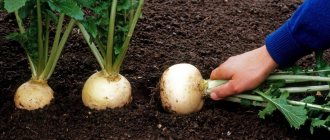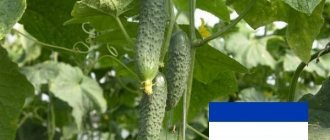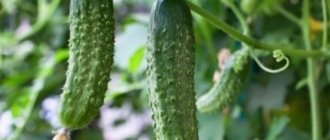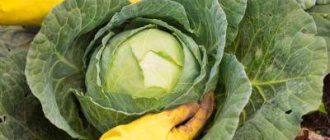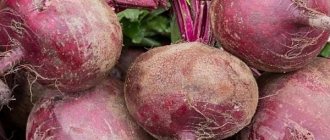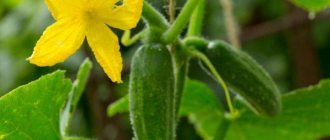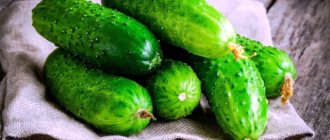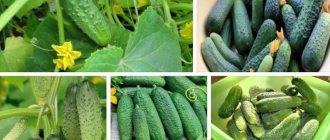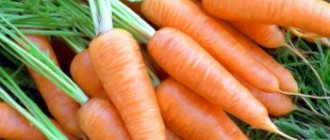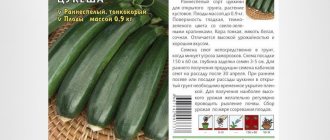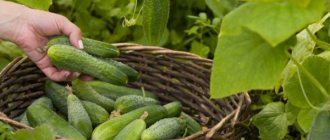Gherkin cucumbers are the most popular among gardeners today. This plant crop differs from ordinary vegetables in appearance, taste, characteristics of cultivation, and care. A huge number of varieties have been bred. Real gherkins should not exceed 5-9 cm in length. Today there are smaller representatives that grow no longer than 7 centimeters. The advantage of this vegetable is the absence of emptiness inside. Their flesh is dense, which is what makes them so crispy when pickled.
Gherkins are both a wonderful appetizer and a decoration for any table. Many varieties of this subspecies of cucumbers are distinguished by high yields and excellent taste; their selection does not stop. They are grown in different ways - in closed and film greenhouses or in open ground. And the choice of the best varieties of gherkin cucumbers for greenhouses is of undoubted interest for gardeners.
Gherkin is a subspecies of cucumber, but smaller in size, no more than 10 centimeters in length, denser and more elastic. They are primarily grown for pickling or pickling, since in this form they turn out to be more appetizing and tasty than ordinary cucumbers. And also, raw, they can be an excellent snack and decoration for any holiday table. They can be grown both in a closed greenhouse and in open soil, where they equally exhibit high yields. There are other ways to successfully grow gherkins: on the balcony, on the windowsill, in a bucket, in bags.
The best varieties of gherkin cucumbers, according to reviews of those who planted and grew them
Cucumber gherkins are grown all over the world. It became widespread due to its taste. They are often used for various workpieces. They are also good fresh. There are many varieties and hybrids of gherkin. The best examples are presented here.
The content of the article:
1. What is a gherkin, types 2. Advantages and disadvantages 3. The best varieties of cucumber gherkins 3.1 “Advance” 3.2 “Gerda F1” 3.3 “Thumbelina F1” 3.4 “Kai” 3.5 “Hummingbird” 3.6 “Corinna F1” 3.7 “Madame F1” 3.8 “Swallowtail” 3.9 “Mikron” 3.10 “Moravian Gherkin F1” 3.11 “Moth” 3.12 “Mels” 3.13 “Parisian Gherkin” 3.14 “Patti F1” 3.15 “Diva” 3.16 “Perfection Itself” 3.17 “Tablecloth Self-Assembled” 3.18 “Slad” cue crunch F1" 3.19 "Champion" 3.20 "Ekol F1" 4. Features of caring for cucumber gherkins 5. Sowing seeds and caring for seedlings 6. Further care of gherkins 7. Reviews of the best varieties of gherkins
Champion
This hybrid is adapted to the climatic conditions of Russia. It is suitable for cultivation even in the north of the country.
Description of the variety
This early ripening hybrid is suitable for growing in open ground. The length of ripened fruits varies from 10 to 12 cm, weight - 90 g. Gherkins are covered with a dark green peel, there is practically no pubescence. As for taste, cucumbers have a sweetish taste. The yield is 25 kg per square meter. m. Despite the average density of the pulp, Champion is used for various methods of preservation and preparation of pickles.
Advantages and disadvantages of the variety
Champion gherkin cucumber has excellent taste. It has a long fruiting period and is disease resistant.
The hybrids Belarusian and Ural Gherkin, Friendly Family, Moth and Marinade deserve attention. But they are less popular.
Description of the best varieties of gherkin cucumbers for open ground
Vegetable growers often boast about the small cucumbers they have grown and rolled into jars in front of their friends. But in most cases these are just unripe simple varieties; gherkin cucumbers for open ground are grown from specially bred varieties. They do not outgrow if harvested untimely and remain small. Let's look at the description of the best varieties of gherkins and find out the features of their cultivation.
What is a gherkin, types
The name of the vegetable is taken from the French (cornichon), which literally means “cucumber”. It is best suited, since the fruits are compact, no longer than 9 cm. In breeding, the gherkin belongs to the category of varieties, hybrids, in which fruit growth is limited.
The compactness of the gherkin is determined at the genetic level. Pickles are the smallest (up to 6 cm). The surface is lumpy. There is no bitterness.
All gherkins are divided into 3 main groups:
- standard – length no more than 9 cm;
- mini – up to 7;
- pickles - up to 4 - 5.
Varieties of gherkin cucumbers - video
This division is arbitrary, since sometimes slightly overgrown fruits are found.
There are different types of cucumbers:
self-pollinating and requiring insect pollination, with different colored thorns, etc. Gherkin cucumbers for open ground, greenhouse conditions, and greenhouses are presented separately. They give a good harvest. However, they are demanding when it comes to fertilizing in order to form healthy bushes. In general, care is easy.
Moravian gherkin F1
These are gherkin cucumbers for open ground.
Description of the variety
The growing season of the bee-pollinated hybrid is 45 days. The first ripe cucumbers appear after 41 days. The bushes are tall, with short branches. From 2 to 4 cucumbers are tied in one internode. The ripe cylindrical fruits are 9 cm long and weigh 75 g. The peel is dark green. The yield of the Moravian gherkin hybrid is 6-7 kg per 1 sq. m. The harvest is harvested daily. The Moravian gherkin is most often used for rolling.
Advantages and disadvantages of the variety
The main advantages of the Moravian gherkin are resistance to diseases and independence from weather conditions. It gives an equally good harvest in both hot and cold summers.
Advantages and disadvantages
Gherkin cucumbers have the following benefits:
- gherkins have excellent taste;
- typical “cucumber” crunch that persists even after heat treatment;
- compactness and decorativeness of the fruit;
- high productivity;
- many varieties and hybrids of gherkins of different ripening periods;
- varieties and hybrids for different climatic conditions.
GOOD VARIETIES OF CUCUMBERS!
Cucumber Courage F1 Cucumber Bingo F1 Cucumber Paratunka F1
Despite the fact that it is common to see gherkins as part of snacks and preparations, they are ideal for preparing fresh salads and slices, as they have excellent taste. Some vegetable growers consider the disadvantages of gherkins to be the inability to obtain seeds for further germination from hybrids. Therefore, new seeds are bought every year.
Attention!
O indicates hybrid.
Bouquet-type gherkins require good nutrition, since many ovaries are formed in the ovary, which results in a high yield. In order for this cucumber to ripen, timely addition of additional nutrition is required. You also need to properly form the bushes by pinching them.
Gherkin cucumbers. How to choose gherkin cucumbers for greenhouses - video
The most productive
New crops are distinguished by high yields. Thanks to the work of breeders, ordinary amateur gardeners are collecting cucumbers in buckets from their beds and in greenhouses, setting real records.
Among the productive species, the following stand out:
- Self-assembled tablecloth is a parthenocarpic hybrid, distinguished by its early harvest and excellent fruit taste. Zelentsy are short, cylindrical in shape with tuberous skin, the flesh is without bitterness, dense and juicy. Collect from 1 square meter to 12 kg of greens;
- Sweet crunch F1 – forms cucumbers of an unusual white color. Valued for its unusual appearance, excellent taste, and high marketability. The bushes are semi-determinate, with medium foliage. The fruits are dense, up to 8 cm in length, white in color with black spines. There is a crunch, which is especially appreciated by lovers of marinades and pickles. Originator – ;
- Brownie is a bouquet hybrid of the first generation (labeled F1). Tasty, productive, with intensive growth of side stems. Produces fruits without pollination (parthenocarpic type), with up to 5 ovaries in the axil. The first batches are removed after 45-47 days, the peak occurs on the 55th day. Needs good nutrition. Gherkins have a classic appearance, with a tuberous surface and white spines;
- Champion – originator of the species – . Mid-season, pollination not required. Zelentsy first harvest - after 45-47 days. At the same time, at the peak of fruiting, it forms up to 30 cucumbers. The fruits are large-tubercular, smooth, green. There are small whitish stripes on the skin. Length – up to 10 cm, flesh with crunch. Collection – 28 kg/m²;
- Advance - refers to well-known varieties, bred by breeders, and is characterized by high yields. Grown by amateurs and farmers, it is valued for its taste and excellent presentation. From 1 square meter up to 14-15 kg of greens are harvested. The fruits are often tuberculate, white-spiked, and even. Grows well in closed ground conditions, on open-air ridges;
Patti F1 is a popular and productive hybrid, grown in shelters (on trellises), in open air (on spread). Originator – . The bushes are medium-sized, with good branching of lateral shoots. Formation of ovaries according to the bouquet type (up to 7 pieces in the bosom), ripening of greens is gradual. The culture is resistant to most traditional infections and has strong immunity to cucumber mosaic. The fruits are small, regular in shape, with thin glossy skin. The structure is tender, juicy, there are no seeds in the capsules. There is no bitterness at the genetic level;
- Sheer perfection is the F1 bouquet type cucumber, the first greens are picked after 35-38 days. Productive, in shelters the indicators reach 27-30 kg/m². Demanding on nutrition, needs proper pruning of vines;
- Marinated cucumber – from the first generation group F1, created specifically for preparations. Retains color and taste in marinades and during preservation. Zelentsy are beautiful, with a “German shirt”, white-thorned. The originator of cucumber is agro. Ripening in 35-40 days. Recommended for greenhouses, parthenocarpic;
- Madame F1 – mid-season (48-50 days), hybrid form. It is distinguished by powerful bushes and strong branching. The yield is stable. Greens up to 8-10 cm, do not outgrow, resistant to yellowing;
- Harmonist - belongs to the bunch type of cucumbers. Plants with small branching of lateral shoots, medium-sized. Cucumbers are cylindrical, smooth, and small in length. The skin is thin, the pubescence is white. Used for all types of workpieces. Pollination is not required, green herb collection rates are up to 14 kg/m²;
- The son of regiment F1 is a very powerful bush with small fruits, up to 7-8 cm. The greens are beautiful, smooth, with a juicy, sweetish structure. There are no seeds inside, no bitterness. This cucumber needs pollination, so planting it in open ground ridges is recommended. With proper feeding from the ridge it gives 11-12 kg/m².
You may be interested in:
The most productive varieties of cucumbers for open ground When spring begins, all gardeners are already on alert - seeds are selected and checked, containers are prepared...Read more...
The best varieties of gherkins
Below are the best gherkins and a brief description. At the end there are several reviews about one of the varieties or hybrids.
Cucumber "Advance"
One of the most common and well-known varieties of gherkins from the breeders of the Gavrish company. The Advance cucumber has a high yield - up to 15 kg per 1 m2. It is often grown for sale, as it has excellent presentation and preservation. The peel is covered with small bumps, often located, with white spines. The Advance cucumber feels good in open and closed ground.
Photo of Advance cucumbers
Gherkin cucumber “Gerda F1”
The hybrid ripens in medium terms. Ripe cucumbers begin to appear on the 45th day after germination. The ovaries are formed into bouquets. There are 5 ovaries in one node. cucumber "Gerda F1" is self-pollinating. The weight of the fetus is no more than 70 grams. It is not subject to deformation, therefore suitable for transportation. The yield of gherkin “Gerda F1” in a greenhouse or under film is up to 14 kg per 1 m2.
Gherkins “Thumbelina F1”
Early ripening, parthenocarpic cucumber hybrid.
Already on the 40th day, tasty and crispy cucumbers are harvested. There is a white edge on the skin. The surface is smooth with small tubercles. Weight from 80 to 90 g. The yield of the Thumbelina gherkin cucumber is one of the highest - up to 18 kg per 1 m2. Suitable for use in any form. The taste is delicate, without bitterness.
Cucumbers "Kai"
Medium ripening cucumber. Requires pollination. Mostly "Kai" is grown in open ground. Up to 3 fruits ripen in one ovary. Cucumbers are up to 8 cm long, with white spines. Weight from 65 to 75 g. To bear fruit, you need to harvest on time. From 1 m2 you get up to 10 kg of cucumbers.
Cucumbers "Kai" - photo of the harvest
Variety of gherkins "Hummingbird"
An ultra-early variety of cucumbers “Hummingbird”, ripening already on the 35th day after the appearance of the first shoots.
The bushes grow strong and strong. The ovaries are formed in a bunch-like manner. The pulp is dense and juicy. There are bumps on the peel. The weight of one cucumber is from 60 to 80 g. The taste of the Kolibri gherkins is good. Productivity is up to 11 kg per 1 m2.
Cucumber "Corinna F1"
The hybrid is ideal for open ground. This is another fast-ripening cucumber variety. A bush of medium height with a small number of branches. The color is bright green. The length of the fruit is up to 10 cm. The yield is relatively low - up to 6 kg per 1 m2.
Gherkins “Madame F1”
Ripens in the middle period, on the 48th to 50th day after germination. The hybrid "Madame F1" has powerful bushes with a huge number of branches. The length of the fruit is from 8 to 10 cm. The average yield is up to 10 kg per 1 m2. There is no tendency to outgrow even when collected late. Cucumbers of this variety are resistant to yellowing.
Photo of Madame cucumber harvest
Cucumber gherkin "Swallowtail"
A self-pollinating hybrid of cucumbers, the ovaries of which are formed in bunches.
The length is no more than 10 cm. There are whitish stripes on the peel - the main difference between the variety. Lumpiness is also present. They look attractive, for which they are valued by vegetable growers. The gherkin bushes "Swallowtail" are tall - up to 2.5 m. It is recommended to harvest ripe fruits once every couple of days to prevent over-ripening and make room for new cucumbers. Swallowtail cucumber can also be grown at home. The length of the vegetable is up to 11 cm. Weight varies from 60 to 110 g. The productivity of the gherkin cucumber “Swallowtail” is defined as good – 11 kg per 1 m2.
Cucumbers "Mikron"
An early ripening variety of cucumbers. Under favorable conditions and proper care, it bears fruit already on the 38th day. Requires pollination. The bushes are of medium height and do not differ in branching. Fruit weight is from 60 to 80 grams, elongated, ellipsoidal in shape. Length – up to 8 cm. Good yield of the “Micron” cucumber variety is from 10 to 15 kg per 1 m2. The peel is dense. The taste of the Micron cucumber is excellent.
Photo on a cucumber bush "Mikron"
Varieties of early cucumbers!
The best early varieties of self-pollinating cucumbers for growing in a greenhouse
Cucumber gherkin “Moravian gherkin F1”
The variety ripens in an average period of 47 to 50 days. Cucumber “Moravian gherkin F1” is intended for open ground. The surface is covered with spines and tubercles. The color is bright green. It is important to collect ripe fruits on time to make room for new cucumbers to appear. The length of one green plant is up to 10 cm. The yield reaches 16 kg per 1 m2. The taste of this gherkin is sweet, without bitterness.
Cucumbers "Moth"
Parthenocarpic variety of cucumbers of medium ripening.
Sometimes, depending on climate conditions, this cucumber is grown as a late-ripening cucumber. “Moth” develops equally well in greenhouses, greenhouses, and garden beds. High density fruit pulp. There is an edge. Fruit weight is about 70 grams. The yield of cucumber “Moth” is up to 8 kg per 1 m2. Most often used for blanks.
Cucumber "Mels"
Excellent ultra-early hybrid of cucumbers. Ripens on the 35th day after the first shoots. Its fruits are thin and elegant, up to 8 cm long. There are no voids inside. Self-pollinating, making it especially suitable for greenhouses. The ovaries are decorated in bouquets or bunches. 6 pieces each. The green peel is covered with tubercles and white edges. The productivity of the Mels gherkin cucumber is extremely high - up to 40 kg per 1 m2. To obtain such a harvest, careful care is required.
Variety of gherkin cucumbers “Mels” - photo of ripe fruits
Variety of gherkins “Paris gherkin”
A variety of cucumbers for open ground. Suitable for most areas of the country. Gives a friendly harvest of beautiful greens. Requires pollination. Tolerates cold weather.
The surface of Parisian gherkin cucumbers is covered with small tubercles and unusual black spines. The weight of one fruit is from 70 to 90 g. No more than 8 cm in length. Cucumber yield is up to 5 kg per 1 m2.
Cucumbers “Parisian gherkin” - photo of gherkins
Cucumber "Patti F1"
One of the most popular gherkins. The “Patti” variety is grown indoors, on trellises, and in open ground. Shrubs of medium height. The shoots on the sides are highly branched. The ovaries are collected in bunches (7 pieces each). The fruits are miniature. The peel is green, slightly glossy. The gherkin pulp is tender and juicy. Without seeds inside and bitter taste. The cucumber variety has a high yield - up to 24 kg per 1 m2.
Cucumber "Primadonna"
A hybrid of Russian selection, ripens early. It has strong branching on the sides. The Primadonna cucumber is resistant to cold weather and is able to bear fruit until the first frost. The shape of cucumbers is round, the ends are pointed. Length up to 11 cm. Can be grown at home. This cucumber variety is especially appreciated for its good taste. The productivity of Primadonna gherkins is high - up to 25 kg per 1 m2.
Ripe gherkins “Primadonna” - photo of the harvest
Cucumbers “Perfection itself”
Early hybrid of cucumbers. The first fruits begin to appear on the 35th day. The bushes grow up to 2 m in height. The ovaries are collected in bouquets (up to 6 pieces in each). It grows well both in open ground and indoors. The length of the cucumber fruit is up to 10 cm. The peel is dark green with white spines. The yield of the cucumber gherkin variety “Perfection itself” is very high. In greenhouse conditions - up to 30 kg per 1 m2, and in lower beds - up to 20 kg.
Cucumber “Tablecloth self-assembled”
Self-pollinating early-ripening hybrid. The fruits are oblong, cylindrical in shape. There are small bumps on the surface. The pulp is tasty, without bitterness inside. Productivity up to 12 kg per 1 m2.
Cucumber “Sweet crunch F1”
A hybrid of cucumbers with medium ripening periods. Sweet Crunch F1 cucumbers grow up to 8 cm in length. The pulp is dense. Suitable for growing in a greenhouse. Weight from 60 to 70 g. They stand out with a light green color against the background of green foliage. The spines are dark. This cucumber has a sweet taste. The yield of the cucumber variety “Sweet crunch” is up to 18 kg per 1 m2.
Photo of ripe cucumbers in the original “Sweet Crunch” color
Cucumber gherkins “Champion”
Mid-season, parthenocarpic hybrid. The first fruits begin to be collected on the 45th day after germination. The surface is covered with large bumps. Color green. Upon closer examination, white stripes can be seen on the peel. The length of the fruit is up to 10 cm. The yield of “Champion” gherkins is very high - up to 28 kg per 1 m2.
Cucumber “Ekol F1”
New variety of gherkin. Ripens on the 42nd – 45th day. Self-pollinating. This variety of cucumbers is mainly grown in greenhouses or greenhouses. You can also collect young fruits that have grown up to 5 cm in length. The degree of ripeness of cucumbers does not affect the taste. The pulp is juicy and sweet. The peel is thin with a white edge. The yield of the “Ekol” gherkin cucumber is up to 9 kg per 1 m2.
Hybrid gherkin “Ekol F1” - photo of a cucumber on a bush
Characteristics and description of gherkin cucumbers
Gherkins are a size, not a type, of cucumber. That is, theoretically, they can be collected from any crop, although salad crops produce the most delicious (in this case, juicy and crunchy) fruits. Gherkins are picked 1-2 days after the ovaries appear - when the length of the fruit is several centimeters (usually no more than five). Even such small, unripe cucumbers are quite tasty, have an appetizing crunch and are ideal for pickling. The characteristics of the fruit directly depend on the best varieties for pickling grown on the site. If you want the harvest to be tasty, beautiful and not bitter, choose appropriate crops.
Gherkins differ from other cucumbers in their size
Gherkin (from the French cornichon) are small cucumbers from 3 to 5 cm long, harvested immediately after the end of flowering of the cucumber plant. They are used mainly for pickling and salting.
Sowing seeds and caring for seedlings
The seedling method is mainly used for growing gherkins. Seeds are purchased and sown immediately, without additional processing, in plastic cups or peat tablets.
Attention!
Seeds go on sale already processed by the manufacturer.
The last option is best - peat tablets, because these plants are sensitive to transplantation. This way you can soften it:
planting gherkins in a permanent place of growth is carried out in the same green coma. The risk of root damage is minimized. Seedlings are planted at the age of 25 days and with the presence of 3 true leaves. Sowing time is taken into account based on the climate of the region.
Features of cultivation
Gherkin-type cucumbers are grown in shelters (greenhouses, tunnels, under arches on ridges), as well as in open ground. Agricultural techniques are standard, but since many hybrid forms and varieties belong to bunch varieties, it is necessary to provide the plants with good nutrition and proper care.
Sowing seeds and caring for seedlings
In most regions of the country, the crop is grown by seedlings. Hybrid seeds are often sold processed and ready for sowing, so they are immediately sown in containers with soil. It is recommended to use peat tablets, pots for cucumber seedlings, or sow seeds in plastic cups.
On a note!
Cucumber does not tolerate picking well and takes a long time to adapt to new conditions. Sowing gherkins in cups and peat tablets eliminates the risk of damage to the root system during planting, since the seedlings are planted immediately with the substrate.
When planted in plastic cups, cucumbers are transplanted to a permanent place using the transshipment method. The timing of sowing is determined taking into account the climate of the area, weather conditions, and the future planting location (in a greenhouse or in a greenhouse). Gherkin seedlings should be 22-25 days old and have 2-3 true leaves. In the Moscow region, cucumbers are sown for seedlings in April; in the Urals, Siberia, and Northwestern regions, cucumbers are sown for seedlings in late April or early May; in the south, they are sown with the onset of heat from the end of March directly into the ground.
Further care for gherkins
Cucumber seedlings are placed in open ground when the soil warms up to +15 degrees. In this case, young plants should be covered with film to protect them from the sun and low temperatures.
Watering is carried out once every 2-3 days. Moisture is especially required at the stage of flowering and fruit formation. An adult cucumber bush needs approximately 4 liters of water.
Gherkins need feeding. Already 3 weeks after planting, fertilizers are applied. In general, during the season it turns out 5 - 6 times with an interval of 10 days between procedures. Before flowering, nitrogen is needed, and after that - potassium and phosphorus.
Advice!
Alternate methods of applying fertilizers: spraying and watering at the root.
Several pruning rules for different heights of cucumber bushes:
- up to 50 cm in height, trim the growth points and leave the leaves;
- up to 1 m, pinching is carried out on the sides (one ovary and a leaf should remain);
- up to 1.5 m and above are also pinched on the sides, leaving a pair of leaves and the same number of ovaries.
Feeding cucumbers!
Feeding cucumbers with folk remedies in open ground
Attention:
the lower nodes on cucumbers are sure to blind due to the rapid formation of ovaries.
It is advisable to promptly remove ripe fruits. It is recommended to process gherkin-type cucumbers on the day of collection, if possible.
Gherkins are distinguished by their high yield and excellent taste, so they should be grown on every plot.
They do not take up much space and, with good care, will delight you with a high-quality harvest.
CARE OF CUCUMBERS AFTER PLANTING! GREAT WAY TO GROW CUCUMBERS! - video
Recommended varieties for open ground
Every gardener strives to harvest his own gherkin cucumbers as early as possible. Therefore, one often wonders which crop varieties are best for open ground.
Moravian gherkin F1
An early-ripening universal hybrid with spindle-shaped, presentable fruits. Often used for salting and preservation. Planted in well-warmed soil by the end of May. Requires timely feeding and proper watering. We are pleased with the harvest in 50-55 days.
Pros: stable yield, excellent taste, resistance to fungal diseases, high yield of marketable products.
Children's F1
An early ripening hybrid capable of self-pollination. Vigorous bush. The fruits are oval-cylindrical in shape with white frequent spines and are universal in use. And the pleasant taste and density of the pulp leave no one indifferent.
See also
Description of the cucumber variety Gunnar and cultivation of an early ripening hybrid
Read
Advantages: high quality fruits that can withstand long-term transportation, productivity, resistance to diseases.
Moth F1
A mid-early hybrid, pollinated by bees, intended for fresh salads, pickles, and winter preparations. Recommended for sowing after the threat of frost. The cucumber is endowed with a coarsely tuberous surface and has dense, crispy flesh.
Advantages: disease resistance, productivity.
Disadvantages: tasty greens require daily picking, otherwise they quickly outgrow.
Philippok F1
Mid-season hybrid, characterized by female flowering. The fruits are short, cylindrical, dark green in color and have white stripes. Harvest at least three times a week once the vegetable reaches 5 cm.
Pros: cucumbers are not able to outgrow and acquire a yellow tint, they are distinguished by intensive fruiting, increased commercial properties, and immunity to diseases.
Thumbelina F1
An ultra-early hybrid that partially pollinates on its own and guarantees 99% germination with proper care. It is cultivated not only in open ground, but also in greenhouses. The fruit has a rich green color, has an oval-cylindrical shape and is not bitter.
Pros: productivity, pleasant taste and aroma, duration of fruiting, resistance to diseases such as powdery mildew, olive spot.
Son of the regiment
A mid-early variety, ripens on the 40th day after sprouting. The greens are cylindrical in shape, widened at the stalk. The surface is covered with small tubercles. Care requires a minimum of manipulation. Pollinated by insects. The bush is medium-sized, medium-climbing.
Positive characteristics: productivity, presentation, good taste, immunity to disease.
Madam
An early-ripening universal hybrid, pollinated by bees. Valued for its crunchy, dense, cylindrical, finely tuberous fruit. The bush is medium-sized. Fruiting occurs on the 40th day after the formation of seedlings.
Advantages: disease resistance, high marketability, excellent taste, productivity.
Moscow
Mid-season hybrid, capable of self-pollination. Long bushes bear fruit on the 80th day after the formation of sprouts. The cylindrical fruit is characterized by a weak, tuberous skin. No bitterness is felt when consumed. Description of the advantages of the Moscow variety: versatility of purpose, disease resistance, good commercial properties.
Gherkin cucumbers: reviews of the best varieties
Tatyana Vasilievna, Pyatigorsk I have several varieties of cucumbers growing in my garden beds. I would like to tell you about the latest find - gherkins of the Ecole hybrid. After the first harvest they immediately became favorites of the whole family. I mainly make winter preparations from them. I collected them when they were very young, up to 5 cm in length, almost every day. Timely harvesting for this type of cucumber is important and directly affects the yield. There were a lot of ovaries. Last year I collected about 40 kg from two bushes during the season.
Alexander Viktorovich, Irkutsk region That year I decided to plant gherkins in my dacha. I chose the Champion variety from the Sedek company. I like their seeds, they are very high quality. Shoots appeared quickly, as I placed them under film. Then he removed it. As always, I took care of the vegetable plantings. The fruits turned out beautiful, smooth and not prickly at all. One bush yielded approximately 10 kg. I wasn't sick. I didn't see any pests either. I would like to note the long fruiting, until October. This variety is best grown in a greenhouse due to the cool climate. Then the yield will probably be even higher.
Elena Ivanovna, Tolyatti We grow cucumbers and tomatoes for sale. Mostly in processed form. Of the cucumbers, the Moravian gherkin hybrid is especially suitable for this purpose. It is easy to care for. You need to choose a sufficiently lit place and carry out systematic watering and apply fertilizers. First they fed it with nitrogen, and after flowering they added potassium and phosphorus. It is important to pick the fruits immediately, as overcooked cucumbers will spoil the taste a little.
Fedor Sergeevich, Vologda Patti is an excellent variety in terms of yield. Ripe cucumbers are emerald green in color. They grow 8 pieces in one ovary. Very beautiful bunches. The length of the cucumbers is no more than 10 cm, and their weight is approximately 60 grams. All Patti gherkin fruits are the same in size and ripen at the same time, which is convenient for harvesting. The peel is dense and can be easily transported without loss of shape, taste, or external decorative effect. I like that Patti is a self-pollinating cucumber variety. I grow cucumber seedlings only in peat tablets. They have already proven their effectiveness with other crops. The seedlings turned out healthy and strong from Patti's seeds. To avoid a bitter taste, you need to water more often. This was suggested to me by a neighbor at the dacha, because when I first picked it I felt bitterness. With balanced watering it does not exist. The fruits are sweet and juicy. Try it yourself!
Mini gherkins
Small gherkins reach 5 to 11 cm in length at maturity and may have small cavities inside the fruit. Due to their size they grow well even on the balcony.
Children's F1
A popular variety for growing on balconies and in glass greenhouses. The ripening period will be 43-49 days.
Good harvest, long fruiting period. Zelentsy are smooth, 7-9 cm, have a cylindrical shape. In closed soil and greenhouse conditions, the maximum yield per season reaches 27 kg/sq. m.
To grow cucumber varieties on your home balcony, take large and spacious boxes for seedlings, and use vertical trellises for fastening. Pay special attention to soil nutrition and moderate watering.
Moth F1
Mid-season variety for film shelters and open ground. Cucumbers are short, no more than 6-8 cm. They have a good yield of up to 10 kg/sq.m. m.
The main advantage is high immunity to diseases, powdery mildew, mosaic, and scab.
Philippok F1
A high-yielding variety of greenhouse-grown gherkins, it is often used for preservation. With the small size of cucumbers – up to 8-9 cm, the volume of fruits per season reaches 10 kg/sq. m.
The variety is valuable for trade - the cucumbers are beautiful, smooth, do not turn yellow during storage, and do not fade. Fresh herbs are collected up to 3-4 times a week.
Karapuz F1
The hybrid is suitable for greenhouses and open ground; it bears fruit for a long time; fruit shoots are formed throughout the season. In addition to high yield, the plant is not susceptible to bacteriosis, powdery mildew, or mosaic.
The table shows a comparison of mini gherkins according to indicators that are important when choosing.
| Name | Type of cultivation | Ripening period | Productivity, kg/sq. m | Growth type | Fruit size, cm | Branching | Pollination | Use |
| Children's F1 | Glass greenhouse, greenhouse, loggia | early (43-48 days) | up to 27 (indoors) | medium height | 7-9 | highly branched | parthenocarpic | salad, pickling |
| Moth F1 | Greenhouse, open ground | mid-season (up to 50 days) | to 10 | medium height | 6-8 | medium branched | bee-pollinated | universal |
| Philippok F1 | Greenhouse, greenhouse, balcony | mid-season (50-55 days) | to 10 | medium height | pickles – 4 cm, mature – 8 cm | medium branched | bee-pollinated | canning |
| Karapuz F1 | Open ground, tunnel, greenhouse | early (42-45 days) | high (the manufacturer does not indicate the exact volume of the harvest) | medium height | 6-8,5 | medium branched | parthenocarpic | universal |
Thanks to the capabilities of modern selection, new varieties appear every day. In order to choose the right variety of gherkins, rely on the characteristics necessary in your case. With proper care, even the most capricious species will produce a good harvest.
0
0
Copy link
Rules for growing gherkins
To get an excellent harvest of small cucumbers, it is important not only to choose the appropriate variety or hybrid, but also to grow the cucumbers correctly. To do this, you should follow simple rules for growing gherkins in greenhouses and open ground:
- Planting seeds - before planting, you need to decide how cucumbers will be grown for the greenhouse: seedlings or direct. With the method of planting seeds for seedlings, the harvest will be obtained 14 days earlier.
- Determining where the bushes will grow - for this type of cucumber you need to choose a place with light and loose soil. The acidity level should not exceed 7.5 pH. Preliminary fertilization of the soil will increase the yield of cucumbers in the future.
- For constant fruiting, you need to water and loosen the beds as needed. The soil should be fertilized at least three times per season with mineral and organic fertilizers. Cucumbers respond well to yeast feeding. It's easy to prepare. A pack of dry yeast is diluted in a 10-liter bucket of water; when the fermentation process begins, the mixture is diluted in 50 liters of water. Plants are watered with this solution.
- Gartering and pinching, if necessary, will also improve the growth of borage and have a beneficial effect on the ripening of fruits.
What do you need to know about pests and diseases of gherkins?
A feature of growing in open beds is the accessibility of bushes to pests. This occurs due to improper use of organic matter. The aphids eat the young leaves, the plant dries out and growth stops. If insects are found on plants, you must immediately sanitize all beds with cucumbers and gherkins.
When watering in hot sunny weather, plant leaves may turn yellow. This occurs due to sunburn. It is recommended to water in the early morning or late evening, when the sun is already setting.
If harvested incorrectly, the bushes will produce fruits of different sizes. Due to old cucumbers, young ones do not have time to ripen, so timely harvesting is necessary.
If you follow these simple rules, you will get an excellent harvest of tasty and crispy gherkins.
Diseases and pests of cucumber
Rust may appear on the shoots of cucumbers in the form of brown spots. They fight it with fungicides. Another common disease is powdery mildew (downy mildew), in which white spots form on the leaf surface. They gradually spread to the entire green mass.
Very often, cucumber leaves are attacked by aphids. As a result, they curl, dry out and fall off. Flowers and ovaries also fall off. You can try to get rid of aphids by treating the plant with an infusion of tobacco, soap and ash. Cucumbers are also affected by spider mites. At the same time, the leaves turn yellow and die over time. They fight it with a soap solution; digging up the soil helps a lot. There is also a pest - the root-knot nematode. Because of this, the plant begins to grow slowly and the yield decreases. Steam treatment helps get rid of the nematode.
Features of cultivation
Caring for cucumber plantings consists of tying up, following the regime of watering and fertilizing, as well as high-quality pollination.
Tying up
The Parisian gherkin bushes well and has developed side shoots, so without tying it to a support, caring for it will be difficult. In addition, fastening to a trellis helps ensure high-quality ventilation, good illumination of the crop, and reduces contact of the plant with the soil. You should consider the method of tying when the borage height is 40–45 cm. At this time, the plant will have up to 5 true leaves. Delay in solving this problem risks that fast-growing shoots may be damaged, and this will have a bad effect on the quality of the crop.
Photo gallery: ways to garter cucumbers
Features of watering and fertilizing
The Parisian gherkin is a rather unpretentious variety, but it needs regular watering and fertilizing. Improper moisture can cause more harm to the plant than good. When carrying out this procedure, you must adhere to the following recommendations:
- Plants should only be watered with warm water and at the roots.
- It is advisable to water in the early morning or evening. Humidification under the scorching rays of the sun can lead to foliage burns, yellowing and drying.
- Immediately after watering, it is recommended to mulch the soil around the plants.
For mulching beds, it is better to choose organic materials: peat, compost, rotted sawdust.
Watering rates:
- During the development of shoots and foliage, watering should be moderate (up to 7 liters of water per 1 square meter once every 5 days).
- During flowering and fruiting, the amount of watering increases. At this time, it is advisable to moisturize the cucumbers daily.
It is recommended to fertilize cucumbers before fruiting begins. This must be done twice with a break of two weeks. Fertilizing is carried out using superphosphate, potassium sulfate and urea. 15 g of each component are dissolved in 5 liters of water and poured over 1 square meter. meter of landing area.
Pollination of cucumbers
The Parisian gherkin cucumber variety is naturally pollinated by bees. To attract them, many gardeners spray their plants with sugar syrup.
In greenhouse conditions or in unfavorable weather conditions, when there are few insects, the ovaries should be pollinated by hand. To carry out artificial pollination, you first need to determine the male and female flowers on the plant. At the base of female flowers there is a small oblong cucumber-shaped process; male flowers do not have it.
The female cucumber flower differs from the male one in that it has an ovary (small cucumber)
The pollination procedure can be carried out in two ways:
- They pick a male flower from the plant and carefully touch it to the female one, making sure that the pistils and stamens touch.
- Using a soft brush or piece of cotton wool, touch first the stamens on the male flower, and then the pistils of the female flower.
Photo gallery: methods of pollinating cucumbers
Growing cucumbers in a greenhouse
Many gardeners prefer to grow small-fruited cucumbers in a greenhouse. This method is convenient for the Parisian gherkin variety; it pleases vegetable growers with early fruiting and high-quality greens with excellent taste.
